Turning Sixteen
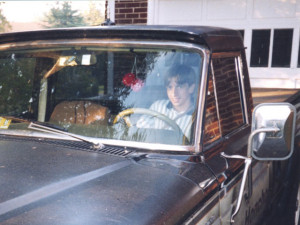
Because of my late-October birthday and the oddities of public school cut-off dates, I was always among the youngest students in my classes. I took driver’s education when I was in tenth grade, as did all of my peers. During the summer between tenth and eleventh I took my behind-the-wheel training, passed the written and behind-the-wheel tests, and received a temporary license . . . that I couldn’t actually use until my birthday several months later. I had all of the requisite training and skills required by the Commonwealth of Virginia to operate a motor vehicle, but I was still fifteen.
Some kids’ parents—especially up here on affluent northern Virginia—buy them brand new BMWs or Lexuses or fast little sports cars when they get their licenses. These cost a fortune to insure, and then the rates skyrocket when those kids immediately crash their fancy new cars into something. Other parents make a somewhat more prudent choice, buying Toyotas and Hyundais for their kids . . . which they also promptly crash. But down in little ol’ Bedford, Virginia, where I lived at the time, most parents made a more prudent choice (whether out of smarts or financial necessity) . . . most of my peers got cheap-ish used cars if they got anything. And it really is best to let new drivers start off with a piece of junk that won’t cost much to insure and won’t be any great loss if it gets in an accident.
In my case, as I approached my sixteenth birthday, my Uncle Scott made us an offer we couldn’t refuse. He was getting a new vehicle for himself, and would no longer need his 1978 Jeep J-10 ‘Honcho’ pickup. The truck was several years older than I was, got twelve miles-per-gallon on a good day, and didn’t have modern amenities like air conditioning or fuel-injection. And on top of that, it had undergone some . . . unusual modifications. It had shag carpeting on the interior of the doors. It had power-windows taken from an Oldsmobile or Buick or something, complete with a four-switch panel (for the truck’s two windows; the other two switches did nothing). And those windows would slam open with force and only inch their way toward closing.
But it ran. It would get me from point-A to point-B. And it resolved the somewhat open-question of whether I would get a car of my own at all. We got the truck, and on the day I turned sixteen I drove it to school while my mom dutifully took photos of me leaving the driveway. Earning the privilege of driving is one of the most important rites of passage for a teen, and I had achieved it . . . in a twenty year old Jeep pickup.
A Weird Truck
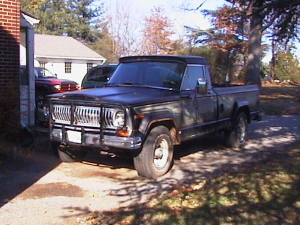
A 1978 Jeep J-10 pickup with the word ‘Honcho’ emblazoned on the side is not the kind of car that a sixteen year old normally wants. It likely would not have been a popular choice in 1978, and it definitely wasn’t a popular choice in 1998. Heck, at that point Jeep had been out of the truck business entirely for a decade.
Even in Bedford, Jeep trucks were a rarity. Old Ford, Chevy, and Dodge trucks could be found on every corner, but a Jeep stood out. And most of the old trucks down that way were no-frills farm trucks that had been put to real use. Unlike its peers, my truck had been a ‘lifestyle’ truck when it was new. It had never toiled on a farm. It had long-faded decorative trim, power steering, and an automatic transmission. Even though I lived in the land of old trucks, I had an oddity.
The other kids that drove old trucks to school were the sons and daughters of local farmers and industrial workmen. They would come to school straight from their early morning hunting expeditions with rifles hanging in the rear windows, often next to a decal of the Confederate battle flag. (There was a standing exception to the ‘no firearms on school grounds’ rule for hunting rifles, as long as they remained locked in the vehicle.) But I was not a native son of Bedford; I spent most of my life in the suburbs. I was the son of a retired United States Coast Guard officer. I had never been hunting, had no affinity for the Confederacy, and was much more comfortable with a computer than with a rifle.
Everything about that truck—and everything about me driving it—was incongruous. But soon, inexplicably, I had fallen in love with it. I embraced the weird, unique quirkiness of the truck as an extension of the weird, unique quirkiness of me.
The Honcho came into my life just about the same time that I began to grow out of my teen-aged obsession with conformity. I was starting to be myself—and starting to find friends who liked me that way. I had become part of a youth group in the town of Altavista, Virginia, about a half-hour away from Bedford, and it was in the Honcho that I began to commute there at least once every weekend, and sometimes more often than that. I drove the Honcho on my first dates, to my first prom, and to the countless events and get-togethers that built some of my most valuable and long-lasting friendships.
Moving On
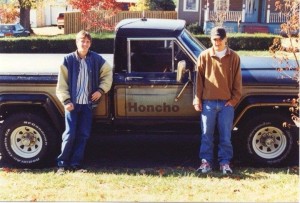
The beginning of the end for the Honcho as my daily-driver was a web development internship . . . my first real job. It was in Roanoke, Virginia, which is about an hour away from home. I left school early each afternoon and commuted off to work.
The rock-bottom gas prices of the late ’90s were beginning to creep up, and the truck’s embarrassingly-poor fuel economy was beginning to strain my very limited finances. Worse, I was driving an hour to work in a truck without air conditioning . . . in Virginia heat and humidity . . . wearing business-casual. No fun. And although the Honcho had not stranded me yet, I also began to be aware that I was driving a twenty year old truck for long distances in very rural areas. Although some of my friends were beginning to get their first cellular phones, I did not yet have one. If the Honcho broke down out in the country somewhere, there was no telling how hard it would be to get help, or how long it would take.
I had driven the Honcho for more than a year without a single ticket or accident, so my parents and I began looking for a car to replace it. We ended up with a 1988 Mercury Sable, which was a fine car when it ran, but ironically proved much less reliable than the Honcho it replaced. But the Sable did have much better fuel economy and, crucially, air conditioning. It was my daily-driver for the rest of high school and the first part of college. But I never loved it—or any subsequent car—quite like I loved that stupid truck.
The Honcho spent most of its time sitting in the driveway from then on. My family kept it for another few years, using it to haul stuff to the junkyard occasionally, but soon they were having a hard time justifying the costs of registering it and insuring it . . . so they sold it. I don’t blame them. There was no rational reason to keep it. It was an unnecessary drain on their finances, not very nice to look at sitting there in the driveway, and sooner or later it was going to start needing the usual regular maintenance that cars need, which would take additional time and money that could be better spent elsewhere.
Fond Memories
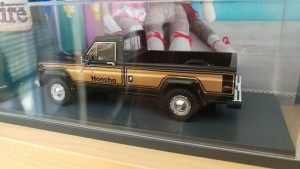
On a purely emotional level, I wish they had kept it. It still felt like my truck, and I still loved it, and I sort-of thought it would always be there.
I had vague dreams of doing a full resto-mod (restoration-modernization) someday, but at the time I did not have any of the things I would need to make that happen. I was a college kid, so I had little time and less money. I probably could have covered the registration and insurance costs, but I had nowhere to park it (and my parents were unlikely to let me keep it in their driveway). Even if I found somewhere to put it, I did not have any way of keeping it in good running condition . . . especially since my daily-driver at the time, a 1994 Mercury Sable, was proving nearly as unreliable as the 1988 model it replaced. Much of my disposable income was going to keeping that car on the road.
So the Honcho was gone, but it was not forgotten. I still looked back on it fondly. And, tucked away in my brain, I still had some half-formed idea of eventually getting an old Jeep pickup and doing that resto-mod. The J-10 trucks were wonderful, under-appreciated vehicles, and I still think they can hold their own against any modern competitor (in capability if not in creature-comforts). And they were pretty rare, selling only a fraction as many copies as Ford, Chevy, and Dodge were moving in the truck market at the time. They stand out.
And yet, despite their rarity, parts aren’t all that difficult to find . . . because everything between the cab and the grille was shared with the much higher-volume Jeep Wagoneer. It’s the best of both worlds: an unusual vehicle with lots of available parts.
But this is all still just an idle dream of mine. For the moment, all I have is a scale die-cast model on a shelf in my living room. And every once in a while I see on old Wagoneer out on the road—or, on even rarer occasion, an actual J-10—and I feel a twinge of longing for that old truck.
It (Probably) Lives!
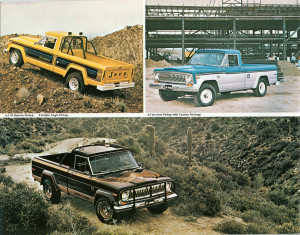
A few months ago, in a fit of curious nostalgia, I decided to try to learn what happened to the cars I used to own (or that my parents owned and I drove). I got a month’s unlimited access to AutoCheck and started running my old vehicle identification numbers (VINs).
The 1988 Mercury Sable that replaced the Honcho as my daily driver was totaled in an accident in 2001, only about a year after we got rid of it. The 1994 Sable that replaced it disappears from the record without explanation in 2004, less than two years after I last saw it. My 1998 Chrysler Cirrus, the first car that I actually bought and registered in my own name, seems to have survived until 2011, about four years after I sold it. My 2002 Mazda Tribute survived until it was totaled in 2010, two years after I sold it. Our 2006 Honda Civic, the first car my wife and I bought new, was totaled in 2014, also about two years after we sold it.
So every car I’ve ever owned was totaled or disappeared from the records within four years of my selling it. Except for the cars I still own today . . . and the Honcho.
According to the AutoCheck vehicle history report, the Honcho went through a number of owners after my family . . . but it never left southern Virginia, it has no salvage listings, and it has never been totaled. It had an active registration as of about a year ago in Evington, Virginia, which is a community south of Lynchburg and north of my old stomping grounds in Altavista. As far as I can tell, my old truck is still on the road. Not only that, but it is probably still driving on some of the same roads that I drove it on back in high school.
I told you those J-10s are tough. And mine seems to have outlived not just the car that was meant to replace it, but four subsequent cars too.
What Now?
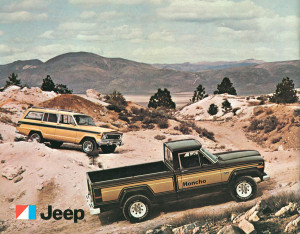
I thought for sure that my specific Honcho would be long dead, and so my idle dream of a J-10 resto-mod did little more than lead me to occasionally search used car sites for old J-10s. Some people have done full restorations, and they seem to sell for around $20,000 . . . proof that these trucks are pretty rare and in-demand. J-10s that have not been restored, but are in good, working shape, seem to go for between $5,000 and $10,000. Examples in poor condition, not running, or needing serious repairs can go for much, much less than that.
But now I’m wondering what kind of shape my old Honcho is in, and whether its current owner would be willing to sell it (if it’s in good enough condition to be worth buying).
The problem is that I have no idea how to find it. All I know is that about a year ago it was registered in Evington, which is the 24550 ZIP code. I’ve spent some time on Google Street View looking for it, and even drove through Evington on the way to visit my in-laws in Bedford. I also contacted a local Jeep club (haven’t heard back) and a local service center that specializes in classic Jeeps (they haven’t seen it). No luck so far.
I’ve estimated that it would take about eight hours to drive every road in the Evington ZIP code in a structured search pattern, but that’s a lot of driving and looking with no guarantee of success. After all, it could be sitting just out-of-sight from the road, or in a garage, or nestled behind some larger vehicle. And in rural areas like Evington, it’s not uncommon for houses to be set far back and nearly invisible from the road.
Even if it happens to sit right by the roadside on your average day, the owner might take it to visit friends or family in another town on the day I come through. Trying to find a single truck in a sixty-five square mile area is pretty much the definition of trying to find a needle in a haystack, and I can’t even guarantee that the truck will be in that area while I’m searching.
But hope springs eternal. Although I am not quite ready to spend a whole day driving around Evington, I will be reaching out to some local businesses and auto shops to see if they’ve seen it, and I’ll drive through any time I’m down that way. I know it’s out there somewhere, and I’m going to keep playing detective and make a real effort to find it. Even if I can’t get it back—because it’s in too poor condition, or because the owner is not interested in selling—it will be nice to know what happened to it. I want some closure! And I want to know if I need to keep stalking AutoTrader looking for a good J-10 to resto-mod.
If you happen to have seen my Honcho recently in southern Virginia, or if you know where it might be, please contact me and let me know the details! It is a black 1978 Jeep J-10 in the ‘Honcho’ trim. When I had it, it had a black brush guard on the front, and was beginning to show some mild body rust toward the rear. It is likely somewhere near Evington, Virginia, and might be seen in Lynchburg, Campbell County, Bedford County, and surrounding areas.
